Issues with gas gauge reading in 51 pacemaker Brougham
I've been having trouble getting my gas gauge to work in my 51 Pacemaker Brougham. I bought a new tank sending unit from ebay. It was supposed to be a very good one according to the seller. I installed it in the car and put 5 gallons of gas in the tank. The gas gauge on the dash didn't even move. I've been trying to troubleshoot it. I did a bunch of stuff trying to figure out what is going on. I will try to describe what I did. I don't know if it will make any sense or if I am way off base on what is going on:
1. First of all I wanted to see if I could get the gas gauge to read anything. I disconnected the wire from the sending unit back at the gas tank and connected a long wire to the disconnected wire. I took the other end of the newly connected long wire up to the drivers seat area of the car. I then connected a 100 ohm potentiometer to the long wire at the drivers seat area. I connected the other side of the potentiometer to ground with a wire. I then turned on the ignition key and started adjusting the potentiometer to try to simulate the gas tank sending unit while watching to see what the gas gauge would read. I found I could get the gas gauge to go from empty to full with a resistance range of the potentiometer from 45 ohms at the empty mark to 8 ohms at the full mark.
2. Then I wanted to see if I could simulate the movement of the sending unit in the gas tank and read what resistance it had at different levels of the float in the tank. I made a jig out of plywood to hold the sending unit and made lines on the jig that showed various levels to represent the levels of fuel in the gas tank. I measured the height of the tank to be 9 inches so I made the range of level from empty to full to be 8 inches. I found that the new sending unit I had purchased had a range of resistance from 82 ohms to 10 ohms. This resistance range is way different than what the range was on the potentiometer to get the gas gauge on the dash to read from empty to full. I don't understand this. Am I missing something or is this new sending unit way off from what it should be?
I made a chart and a graph to attempt to visualize what was going on. I am going to try to include them with this post. Hopefully they will be readable.
Any thoughts appreciated.
Rob
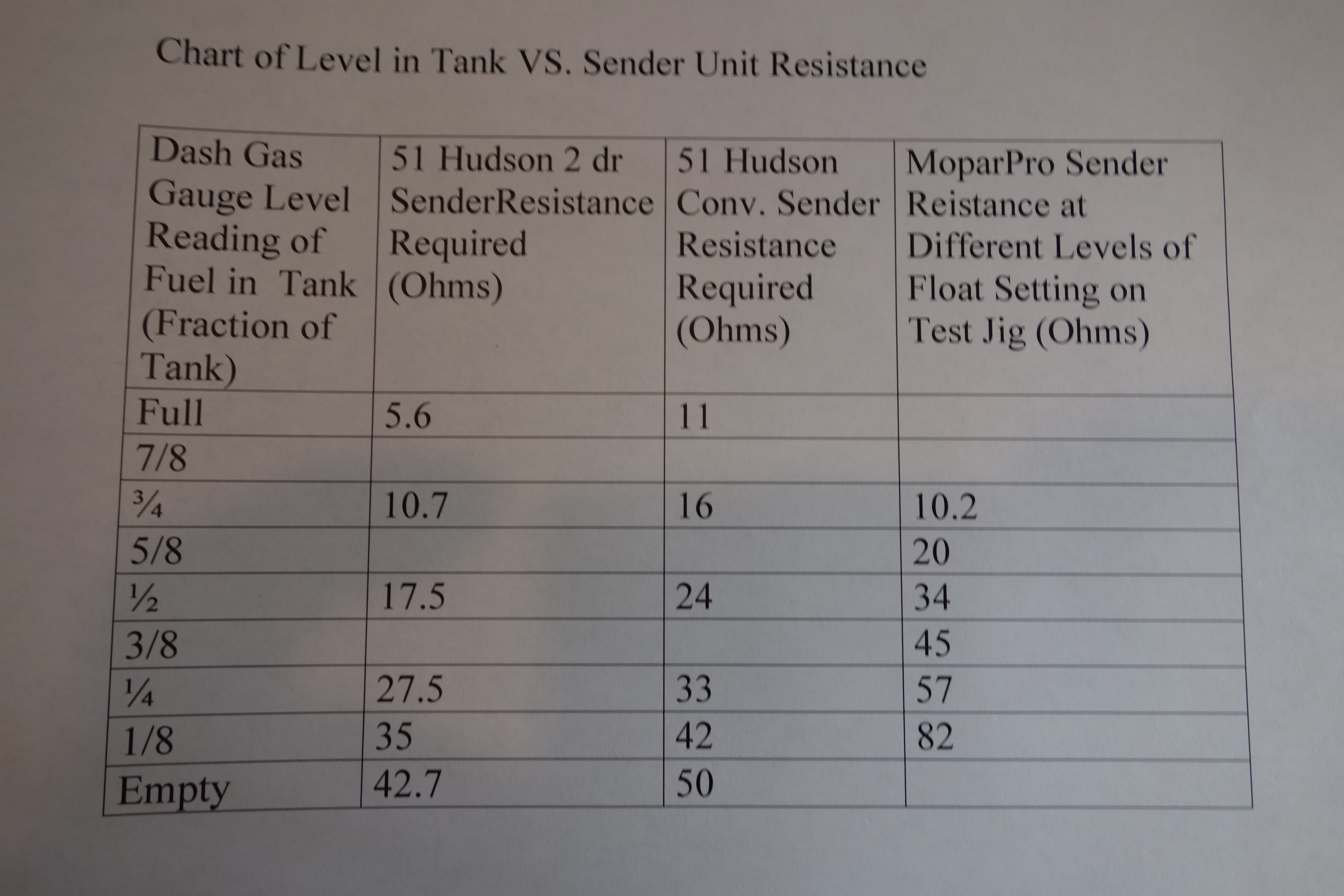
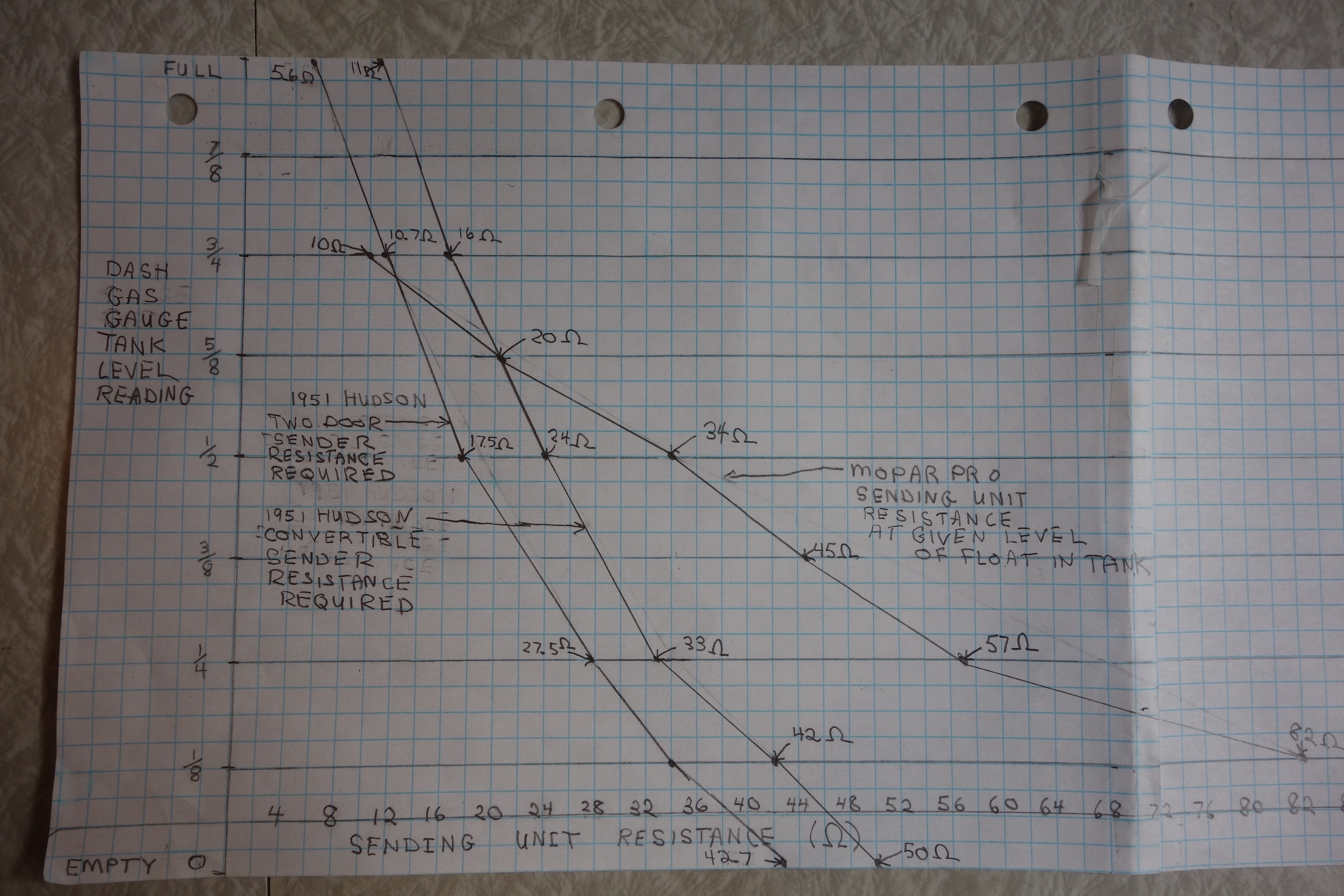
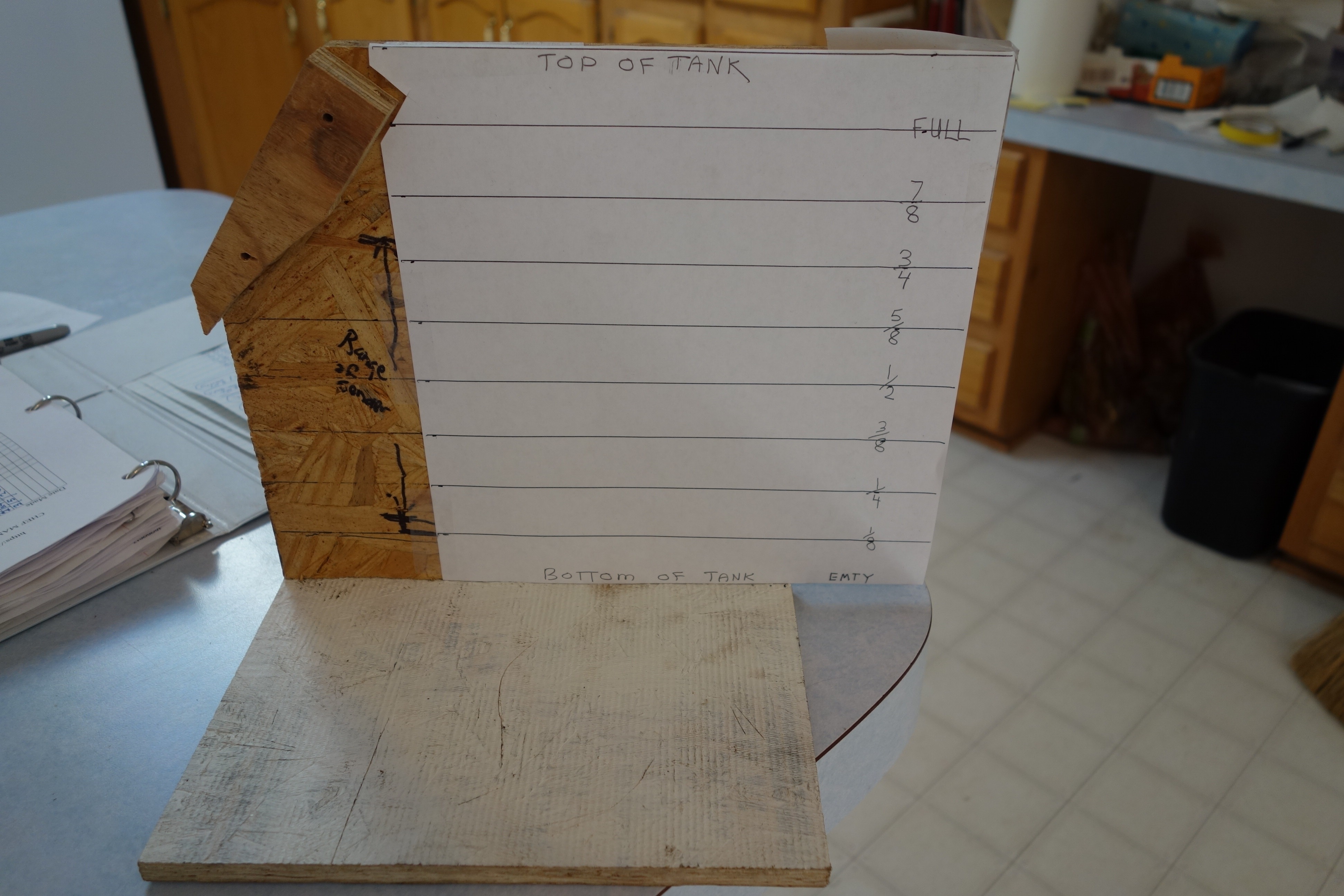

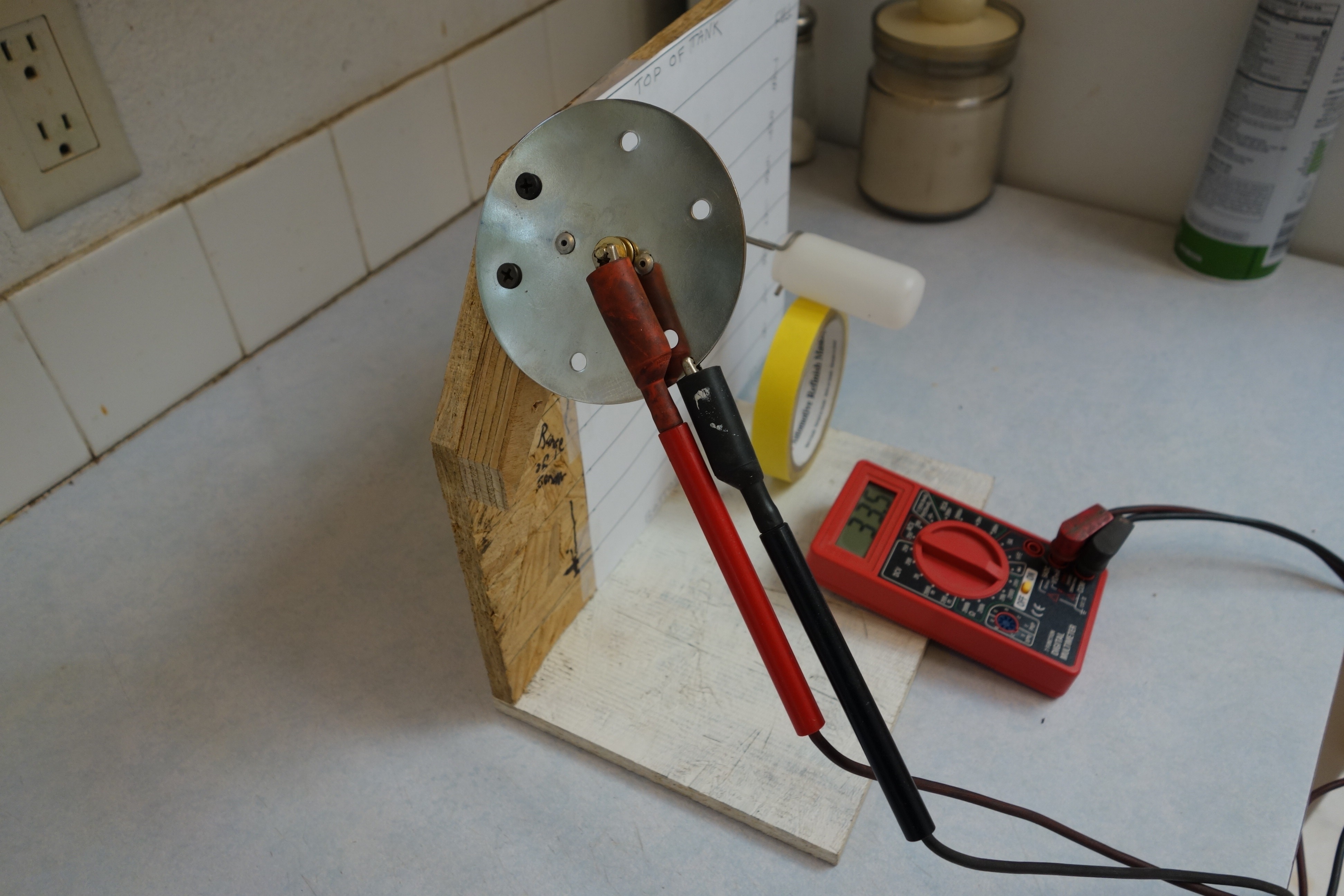
1. First of all I wanted to see if I could get the gas gauge to read anything. I disconnected the wire from the sending unit back at the gas tank and connected a long wire to the disconnected wire. I took the other end of the newly connected long wire up to the drivers seat area of the car. I then connected a 100 ohm potentiometer to the long wire at the drivers seat area. I connected the other side of the potentiometer to ground with a wire. I then turned on the ignition key and started adjusting the potentiometer to try to simulate the gas tank sending unit while watching to see what the gas gauge would read. I found I could get the gas gauge to go from empty to full with a resistance range of the potentiometer from 45 ohms at the empty mark to 8 ohms at the full mark.
2. Then I wanted to see if I could simulate the movement of the sending unit in the gas tank and read what resistance it had at different levels of the float in the tank. I made a jig out of plywood to hold the sending unit and made lines on the jig that showed various levels to represent the levels of fuel in the gas tank. I measured the height of the tank to be 9 inches so I made the range of level from empty to full to be 8 inches. I found that the new sending unit I had purchased had a range of resistance from 82 ohms to 10 ohms. This resistance range is way different than what the range was on the potentiometer to get the gas gauge on the dash to read from empty to full. I don't understand this. Am I missing something or is this new sending unit way off from what it should be?
I made a chart and a graph to attempt to visualize what was going on. I am going to try to include them with this post. Hopefully they will be readable.
Any thoughts appreciated.
Rob





0
Comments
-
If you lengthen the rod holding the float won't it reduce the swing at both the top and bottom of the scale and give you readings closer to the Hudson one?
0 -
Rob the gas gauge in the dash operates with a constant voltage regulator. The tank sender provides a variable resistance to the gauge for pointer deflection. There are 2 pdf pages at the bottom of the “fuel” page on my website. It also show the proper ohm readings for a hudson fuel gauge sender. Good luck...,
0 -
My crude drawing on phone of how these components are connected
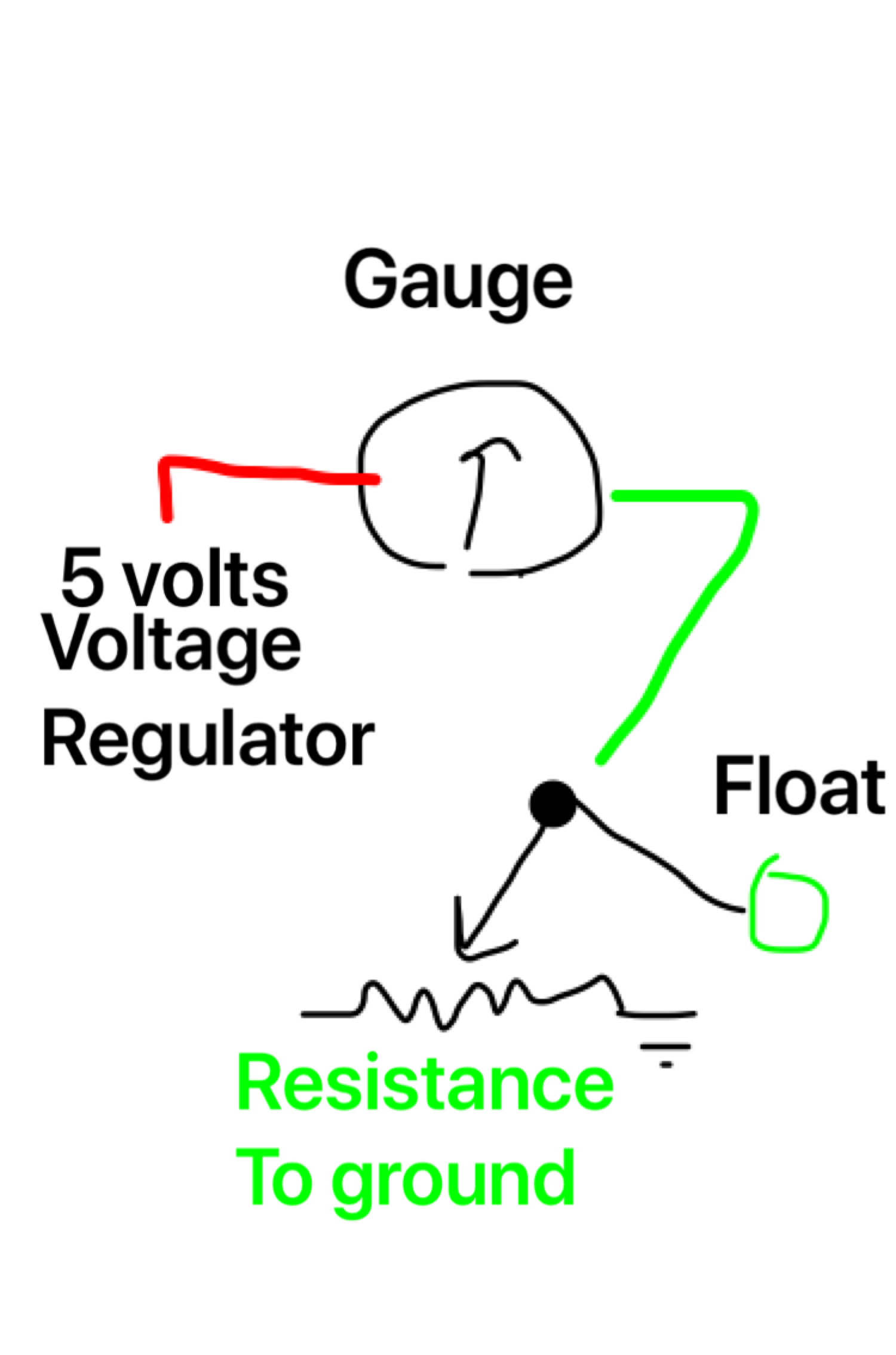 0
0 -
Your gauge is faulty. Te correct range for the rheostat in the tank is 10-90 ohms.0
-
Thanks a lot for the help guys. Ken I looked up the documentation you mentioned in the Fuel section of your website. ( I need to look there first I know, I wish I could get more disciplined). There it mentioned putting a resistor in parallel with the sending unit. I hadn't thought of that. I put the 100 ohm pot. temporarily in parallel with the sending unit and amazingly I was able to adjust it so it came in close through the whole range of levels of the float. I put everything back together with an 82 ohm resistor in parallel with the sending unit and now the gas gauge is reading about 1/8 tank with 5 gallons of gas in the tank. That's close enough for me.
Ratlee I think you are right about lengthening the float arm. I was going to try that if nothing else would work. In order to do it I would have to modify the new unit with no chance of ever returning it.
Geoff. It looks like the sending unit I bought has close to the same range of resistance as the 10 - 90 ohms you mentioned is the correct amount. It raises another question. I checked the resistance required to make the dash gauge go from empty to full on 2 of my stepdowns and they both were reasonably close to each other at an average of 8 - 46 ohms. (you can see the numbers in the chart). It seems surprising that they would both be off around the same amount. Any thoughts why that would happen? Maybe just coincidence.
Rob0 -
Have you checked the voltage regulator. You need a constant 5 volts at the gauge.0
-
Geoff, I did measure the voltage back at the tank on the Brougham, but not the convertible. I measured it when the sending unit was disconnected. It was kind of cycling around 6V from what I remember. I think I read in the shop manual that the regulator is crude ,with contacts that slowly cycle. Its more of an average 5 volts.0
-
That is correct. to check the gauge operation, you need to temporarily connect ground to the tank unit and the gauge should deflect across to full. You also need to run a good ground wire to one of the mounting screws on the tank unit. I had trouble with my Jet not reading full, and it was a resistance developed between the rheostat and the connection. Good luck,
Geoff
0
Categories
- 36.9K All Categories
- 112 Hudson 1916 - 1929
- 20 Upcoming Events
- 92 Essex Super 6
- 28.6K HUDSON
- 571 "How To" - Skills, mechanical and other wise
- 995 Street Rods
- 151 American Motors
- 178 The Flathead Forum
- 49 Manuals, etc,.
- 78 Hudson 8
- 44 FORUM - Instructions and Tips on using the forum
- 2.8K CLASSIFIEDS
- 608 Vehicles
- 2.1K Parts & Pieces
- 77 Literature & Memorabilia
- Hudson 1916 - 1929 Yahoo Groups Archived Photos

